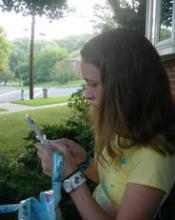DENVER – Teens who overuse cell phone texting or social networking Web sites have disturbingly high rates of a wide range of health risk behaviors, a large cross-sectional study showed.
"The startling results of this study suggest that, when left unchecked, texting and other widely popular methods of staying connected can have dangerous health effects on teenagers," possibly associated with a general lack of adult supervision, Dr. Scott Frank said at the annual meeting of the American Public Health Association.
He presented the results of a survey completed anonymously by 4,257 teens at 20 schools in Cuyahoga County, Ohio. Of the responders, 20% were what Dr. Frank classified as "hypertexters," based upon their self-reported texting an average of 120 or more times per day on school days.
Based upon their responses on the Youth Risk Behavior Survey, completed as part of the anonymous survey, these hypertexters were an adjusted twofold more likely to have ever tried alcohol, 43% more likely to be binge drinkers, 32% more likely to be current users of marijuana, and 40% more likely to have tried cigarettes than kids who texted less or, as was true for 22% of students, not at all.
They were also 42% more likely to report feeling depressive sadness, 55% more likely to have been in a physical fight during the past year, 3.4-fold more likely to have ever had sex, and 88% more likely to have had four or more sexual partners. In addition, they were 39% more likely to report skipping class, 63% more likely to average less than 7 hours of sleep, 60% more likely to get poor grades, 39% more likely to watch television for 3 hours or more daily, and 67% more likely to have been a victim of cyberbullying.
They were also 2.7-fold more likely to rarely or never wear a bike helmet and 39% more likely to rarely or never wear a seat belt, reported Dr. Frank of Case Western Reserve University, Cleveland.
The relative risks were adjusted for age, sex, race, parental education, and household structure. This was necessary because hypertexters were more likely to be minority females of low socioeconomic status with no father in the home.
Hypernetworking was defined as spending an average of more than 3 hours per school day on Facebook or other social networking Web sites. This threshold was met by 11.5% of students; another 22% reported having no involvement at all with such Web sites. Hypernetworkers were an adjusted 79% more likely to have tried alcohol, 69% more likely to be current binge drinkers, and 32% more likely to be current users of marijuana. They were also twice as likely to have had sex before age 13, and 60% more likely to have had four or more sexual partners.
Like the hypertexters, the hypernetworkers were more likely to get poor grades, watch a lot of television, get too little sleep, have been in a physical fight during the past 12 months, and experience cyberbullying. They were also 2.5 times more likely to report rarely or never using a bike helmet or seat belt.
A particularly notable finding was the overall poor emotional health of the hypernetworkers, Dr. Frank continued. They were 2.5 times more likely to indicate they had made a suicide attempt, 92% more likely to report feeling depressive sadness, 2.5-fold more likely to have engaged in deliberate self-harm without suicidal intent, 2.2-fold more likely to report feeling a high level of stress, and 3.4-fold more likely to characterize themselves as having an eating disorder.
The highest levels of health risk behaviors were reported by the 3.8% of teens who were both hypertexters and hypernetworkers, according to Dr. Frank.
He noted that a recent national study by the Kaiser Family Foundation concluded that 69% of 11- to -14-year olds and 85% of 15- to 18-year-olds owned a cell phone in 2009. Nearly half of students in grades 7-12 reported texting daily, averaging 57 texts and devoting 1 hour and 35 minutes per day to the activity. Of the texters, 84% indicated their parents had no rules regarding text messaging.
The lack of parental oversight regarding this explosively popular activity is a key point, in Dr. Frank’s view. It’s not that hypertexting directly leads to sex, drugs, and vehicular recklessness; rather, it’s that hypertexting bespeaks a lack of parental control having broad ramifications.


